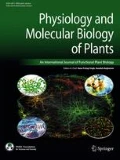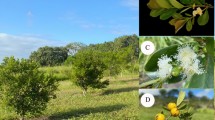Abstract
Chlorophytum borivilianum is a traditional medicinal plant distributed throughout the tropics and subtropics. In the present investigation, AFLP analysis was used to assess the genetic similarity among 34 accessions. Nine primer sets of AFLP amplified 612 fragments, of which 246 fragments were found to be polymorphic. The average number of polymorphic bands per AFLP primer pair was 27.33. The amplified fragments ranged from 50 base pairs to 600 base pairs. Significant correlation was observed between total number of amplified fragments and polymorphic bands (p > 0.05) per primers. Cluster analysis based on AFLP data revealed limited genetic variation within the thirty four accessions collected from various parts of Central Indian forests.



Similar content being viewed by others
Abbreviations
- SSR:
-
Simple sequence repeat
- AFLP:
-
Amplified fragment length polymorphism
- RAPD:
-
Random amplified polymorphic DNA
- ISSR:
-
Inter simple sequence repeats
- RFLP:
-
Restriction fragment length polymorphism
- PIC:
-
Polymorphic information content
- DNA:
-
Deoxyribonucleic acid
- PCR:
-
Polymerase chain reaction
- UPGMA:
-
Unweighted pair group method with the arithmetic averaging algorithm
- PCA:
-
Principal component analysis
References
Bradley KF, Rieger MA, Collins GG (1996) Classification of Australian garlic cultivars by DNA fingerprinting. Aust J Exp Agric 36:613–618
Chen Y, Wang L, Ma Y, Xiao H, Tang L, An Q (2010) Genetic diversity of Ligusticum chuanxiong based on inter simple sequence repeat (ISSR) and amplified fragment length polymorphism (AFLP) analyses. Afr J Biotechnol 9:8290–8295
Doyle LJ, Doyle JJ (1990) Isolation of plant DNA from fresh tissue. Focus 12:13–14
Dwivedi R, Sharma DK (2011) Assessment of genetic diversity among collected genotypes of Chlorophytum borivilianum using random amplified polymorphic DNA (RAPD) markers. Afr J Biotechnol 10:5268–5272
Geetha K, Maiti S (2002) Biodiversity in Chlorophytum borivilianum Santapau and Fernandes. PGR Newsletter 129:52–53
Gepts P (2004) Crop domestication as a long-term selection experiment. In: Janick J (ed) Plant Breed Rev 24:1–44
Hosokawa K, Minami M, Kawahara K, Nakamura I, Shibata T (2000) Discrimination among three species of medicinal Scutellaria plants using RAPD markers. Planta Med 66:270–272
Ipek M, Ipek A, Simon P (2003) Comparison of AFLPs, RAPD markers, and isozymes for diversity assessment of garlic and detection of putative duplicates in germplasm collections. J Am Soc Hort Sci 128:246–252
Jaccard P (1908) Nouvelles recherches sur la distribution florale. Bull Soc Vaud Sci Nat 44:223–270
Jatav DS, Tiwari S, Kumar S, Saini N (2011) Study of polymorphism among mother stocks and genetic fidelity of regenerated plants in Chlorophytum spp. using RAPD markers. J Tropic Biodivers 19 (in press).
Katoch M, Kumar R, Pal S, Ahuja A (2010) Identification of Chlorophytum species (C. borivilianum, C. arundinaceum, C. laxum, C. capense and C. comosum) using molecular markers. Indus Crop Prod 32:389–393
Khan S, Mirza KJ, Abdin MZ (2009) Development of RAPD markers for authentication of medicinal plant Cuscuta reflexa. EurAsia J BioSci 4:1–7
Kothari SK, Singh K (2001) Evaluation of Safed musli (Chlorophytum borivilianum Santapau and Fernandes) germplasm. J Spices Arom Crops 10:147–149
Koul AK, Gohil RN, Langer A (1997) Prospects of breeding improved garlic in the light of its genetic and breeding systems. Euphytica 28:457–464
Kumar B, Verma AK, Singh HP, Mishra HO, Lal RK (2008) Genetic divergence and correlations study in Chlorophytum borivilianum. J New Seeds 9:321–329
Li W, Li QX, Jian QL, Guang XW (2004) Genetic diversity of Potamogeton maackianus in the Yangtze River. Aquat Bot 80:227–240
Li WG, Wang BG, Wang JB (2006) Lack of genetic variation of an invasive clonal plant Eichhornia crassipes in China revealed by RAPD and ISSR markers. Aquat Bot 84:176–180
Maiti S, Geetha KA (2005) Characterization, genetic improvement and cultivation of Chlorophytum borivilianum—an important medicinal plant of India. Pl Genet Res 3:264–272
Mehetre SS, Gomes M, Eapen S (2004) RAPD analysis of hybrid nature of the offspring of Gossypium hirsutum x G. raimondii. Curr Sci 84:24–28
Misra A, Shasany AK, Shukla AK, Darokar MP, Singh SC, Sundaresan V, Singh J, Bagchi GD, Jain SP, Saikia D, Khanuja SP (2010) AFLP markers for identification of Swertia species (Gentianaceae). Genet Mol Res 9:1535–1544
Nayar MP, Shastry ARK (1988) Chlorophytum borivilianum. In: Nayar MP, Sastry ARK (eds) Red data book of Indian plants. Botanical Survey of India, Calcutta, India 2:142
Negi MS, Sabharwal V, Wilson N, Lakshmi kumaran MS (2006) Comparative analysis of the efficiency of SAMPL and AFLP in assessing genetic relationships among Withania somnifera genotypes. Curr Sci 91:464–471
Ordoñez A, Torres LE, Hidalgo MG, Muñoz JO (2002) Análisis citológico de una variante genetic somática de ajo (Allium sativum L.) tipo rosado. Agriscientia 19:37–43
Oudhia P (2001) Problem perceived by Safed Musli (Chlorophytum borivilianum) grower of Chhattisgarh (India) region: a study. J Med Arom Plant Sci 22(4A)/23 (1A):396–399
Paredes MC, Becerra VV, María I, González A (2008) Low genetic diversity among garlic (Allium sativum L.) accessions detected using random amplified polymorphic DNA (RAPD). Chilean J Agric Res 68:3–12
Pejic I, Ajmone-Marsan P, Morgante M, Kozumplick V, Castiglioni P, Taramino G, Motto M (1998) Comparative analysis of genetic similarity among maize inbred lines detected by RFLPs, RAPDs, SSRs and AFLPs. Theor Appl Genet 97:1248–1255
Powell W, Morgante M, Andre C, Hanafey M, Vogel J, Tingey S, Rafalski A (1996) The comparison of RFLP, RAPD, AFLP and SSR (microsatellite) markers for germplasm analysis. Mol Breed 2:225–238
Rohlf FJ (2000) NYSYS-pc: numerical taxonomy and multivariate analysis system, version 2.1. Exeter publications, Setauket
Russi L, Moretti C, Raggi L, Albertini E, Falistocco E (2009) Identifying commercially relevant Echinacea species by AFLP molecular markers. Genome 52:912–918
Sarwat M, Das S, Srivastava PS (2008) Analysis of genetic diversity through AFLP, SAMPL, ISSR and RAPD markers in Tribulus terrestris, a medicinal herb. Plant Cell Rep 27:519–528
Thakur GS, Bag M, Sanodiya BS, Debnath M, Zacharia A, Bhadauriya P, Prasad GB, Bisen PS (2009) Chlorophytum borivilianum: a white gold for biopharmaceuticals and neutraceuticals. Curr Pharm Biotechnol 10:650–666
Tripathi N, Saini N, Tiwari S (2011) Assessment of genetic diversity among Aloe vera accessions using amplified fragment length polymorphism. Int J Med Arom Plants 1:115–121
Vijaya NK, Chavan PD (2009) Chlorophytum borivilianum (Safed musli): a review. Phcog Rev 3:154–169
Vos P, Hogers R, Bleeker M, Reijans M, van de Lee T, Hornes M, Frijters A, Pot J, Paleman J, Kuiper M, Zabeau M (1995) AFLP a new technique for DNA fingerprinting. Nucleic Acids Res 23:4407–4414
Wuang YY, Zhou J (1995) Blood relationship analysis and breeding procedures comparison between Chinese and American main tobacco cultivars. Chin Tobacco Sin 3:11–22
Acknowledgements
We are thankful for grants from Madhya Pradesh Minor Forest Produce Cooperative Ltd., Bhopal, MP, India and Department of Plant Physiology, Jawaharlal Nehru Agricultural University, Jabalpur, India for providing accessions of C. borivilianum.
Author information
Authors and Affiliations
Corresponding author
Rights and permissions
About this article
Cite this article
Tripathi, N., Saini, N., Nair, P. et al. Lack of genetic diversity of a critically endangered important medicinal plant Chlorophytum borivilianum in Central India revealed by AFLP markers. Physiol Mol Biol Plants 18, 161–167 (2012). https://doi.org/10.1007/s12298-012-0108-8
Published:
Issue Date:
DOI: https://doi.org/10.1007/s12298-012-0108-8




